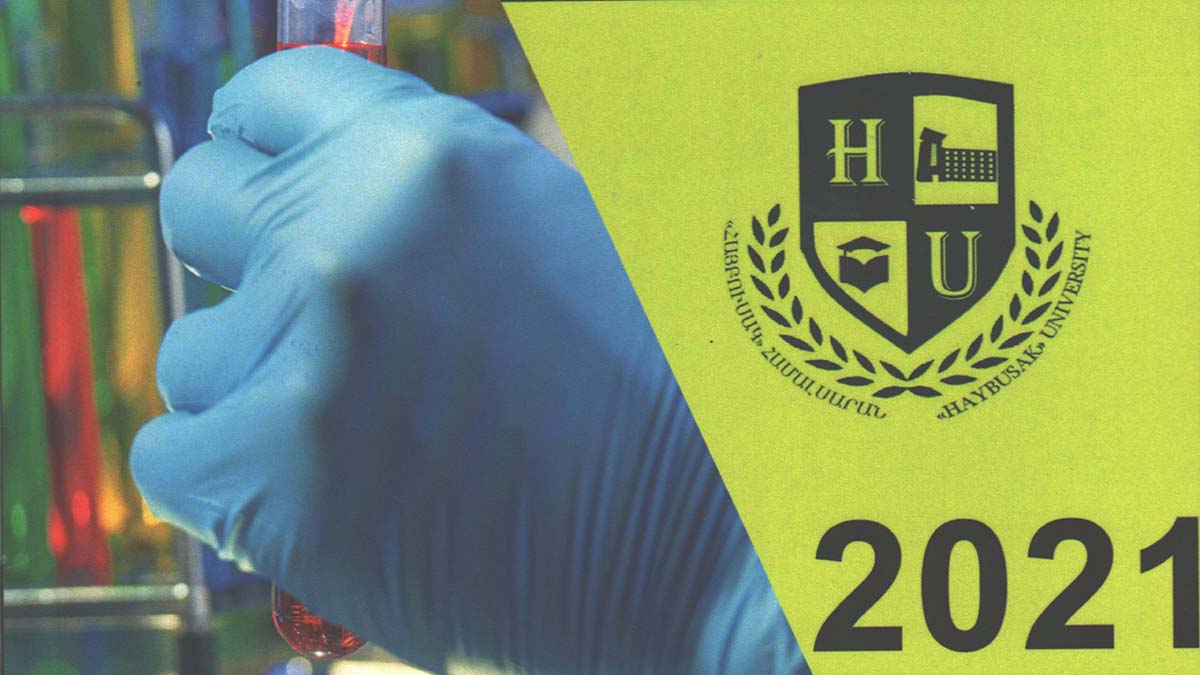SPINAL MICRO ENDOSCOPY ACCORDING TO MIBRAR
BABAYAN ARSEN
Dr. Med., Professor
Lead Specialist and founder of MIBRAR® Center, Munich, Germany
Abstract
In comparison to the conventional minimally invasive spinal endoscopy and microinvasive spinal endoscopy according to MIBRAR, the following should be emphasized: for example, a herniated disc can have two causes:
- A traumatically deformed disc; or
- Long-term degeneration of the intervertebral disc tissue, which can ultimately be the cause of extrusion of the tis sues.
Spinal endoscopy according to the MIBRAR method is not only used to remove the symptoms of the intervertebral disk, for example the removal of an intervertebral disc disease, but also – and this is of decisive importance – for the most complete reconstruction and regeneration of the affected segment regardless of the cause of the pathology whether trauma or degeneration. Moreover, this can lead to complete restoration of the disc shape, height, and function.
Using the micro-invasive intervertebral disk endoscopy according to MIBRAR, not only the intervertebral disc disease is removed, but also intervertebral and segmental reconstruction is carried out at the same time, and intervertebral disk regeneration is initiated
This is done with autologous intradiscal transplantation:
- Anti-inflammatory factors,
- Growth factors and
- Mesenchymal stem cells
In summary, the advantages of spinal endoscopy using the MIBRAR method are as follows: Not only the sequelae (eg, disc herniation), but also the cause (degenerated disc, or chronically or traumatically damaged tissue) is remedied. Overall, the particularly lasting effect of spinal endoscopy according to MIBRAR has to be emphasized. Because a unique, outpatient procedure and the awarding of the multifunctional, body-active substances often result in an excellent result with a lasting effect over many years and gives the patient a long-lasting natural quality of life.
Keywords
Spinal stenosis, Endoscopy, micro-invasive, intervertebral disc, regeneration, reconstruction, Autolog
Introduction
The operative procedure of the endoscopic interventions on the spine such as e.g. on spinal canal stenosis, or on foramina stenosis is nowadays endoscopic, i.e. minimally invasive and has been practiced for about 20 years. This technique is used in all spine areas (neck, chest, and lumbar spine area) in combination with different access routes and using different, operational-specific 5 endoscopes. The present state of the art of minimally invasive spinal endoscopy is associated with a standard surgical procedure, as the instruments and methods developed so far require a certain space, including an incision, access, and overall intervention using a general anesthesia or analgo sedation and corresponding OP environment. Especially in the presence of the degenerative intervertebral disc tissue, a recitif i.e. a new intervertebral disc disease can occur. For the degenerative intervertebral disc tissue represents an existing instability of the segment and this is not cured or eliminated by the sole removal of the intervertebral disc disease. Another important aspect is the fact that the intervertebral disc compartment in question loses its former shape or height and can lead to other pathologies of the spine. In such pathologies, further complications may arise, e.g.
- a spinal canal stenosis,
- a foraminal stenosis,
- a segment instability
- a scoliosis. or
- a defect in the sagittal balance
In this context, according to today’s standard methods, long-term measures are inevitable, such as, for example, spondylodesis, the use of intervertebral disc prostheses or even a stiffening of spinal segments by the use of screws, titanium, etc.
This, in turn, in many cases causes not only a feeling of strangeness in the nonparticulate material, but also the formation of undefined secondary defects over time.
For example, the stiffness of the movable spine (rolling over 4-5 floors) can lead to other, unnatural movements (malo-biodynamics) which can now reload and possibly damage the previously healthy regions of the spine.
Methods
In contrast, spinal endoscopy does not require such an intensive procedure according to the MIBRAR method and can usually be performed ambulatory, without anesthesia or under local anesthesia or under analgo sedation. In the case of spinal endoscopy according to MIBRAR, the great advantages are
- that the operation can be realized without cutting, through a small needle opening, it can be penetrated into the relevant disc compartment and through the consistent use of micro-dimensional instruments the entire procedure can be performed in a micro-dimensional manner;
- that the MIBRAR method allows the entire operation to be performed micro invasively by the use of a micro-endoscope equipped with a special high-resolution micro-dimensional optics.
These body-active substances are extracted from the body’s blood and the subcutaneous fat of the patient directly before the outpatient intervention of the spinal endoscopy after MIBRAR and processed according to the CGF or Lipogems® technology for the subsequent application.
Results
- The old shape, functionality and resilience of the segment are restored.
- the procedure according to MIBRAR without incision prevents the formation of a larger tissue injury that normally only heals in a week-long process.
- In order to effectively perform the reconstruction and regeneration by the body’s active substances, the tissue injury should be minimal so that the regenerative concentrate can be used with the maximum effect for the correlate. For, of course, the mesenchymal cells have the tendency to migrate to the place where they are “used most”. Fresh tissue injury attracts many regenerative factors, with the result that the regenerative effect of the concentrate is largely lost to the original problem (e.g., elimination of the intervertebral disc disease).
- It makes a big difference, therefore, whether valuable body-active substances are administered minimally invasively with the formation of a tissue injury or micro invasively with avoiding a tissue injury. The lower the tissue injury, the more intense is the successful effect of the body’s active ingredients.
- In general – as with all outpatient micro-therapeutic procedures according to MIBRAR – the saving of the anesthesia and the operating costs, which is the case with the usual treatment methods, not only gained a lot of time here, but also the physical stress or the potential risks of a larger procedure are considerably lower for the patient.
- The long-term effect differs in that not only the current pain state and the functional problem are solved, but by the pure administration of body-active substances, side effects or possible long-term negative sequences by medicaments, prostheses or other non-particulate materials do not occur. For example, a frequently unknown side effect of the pain reliever Cortisone, which appears to be helpful at first, results in an increasing weakening of the spinal tissue, which can be the cause of future vertebral damage.
- On the contrary the application of the body’s active ingredients stimulates the active reconstruction and regeneration of the original spine functions until the natural resilience is restored.
- Contrary to the conventional treatment methods, which do not rule out possible stiffening of spinal segments, the natural mobility of the spine is not restricted by the natural, regenerative reconstruction by the granting of body active substances and the stability of the spinal column is not diminished.
Discussion
Compression ventral lateral stenosis due to a herniated disc in the cervical spine
Case: 1.A.BSV.5.20.25
38 years (female)
Status before the surgery:
Pain complains in the spine, especially in shoulder blades and lumbar part of the spine. Also for the last six month, dull pain complains in cervical area of the spine. Impaired sensitivity of fingers and often headaches.
Diagnosis:
Compression ventral lateral stenosis of spinal canal C4-C6. Compression stenosis of C6 roots. Ostecheondrosis C3-C7. Arthrosis of C4-C6 facet joints. Degeneration of C4-C6 intervertebral discs. Cervical kyphosis. Left central hernia 1,9 mm of C4/C5. Central lateral hernia 5,8mm on the right and 2,3mm on the left of C5/C6.
Clinical examination:
Clinical picture corresponds to MRI images. Compression signs of C6 roots. Inflammation signs of facet joints. Pain during the palpation of cervical area C5 and C6. Paraparesis of right hand. Pains and right turn movement limitations, hyper-tonus of muscles (hypertonic muscle spasm) in cervical and interscapular areas.
Performed surgery:
Microinvasive surgical intervention by MIBRAR® method: Flexible catheterization with spinal canal dilatation of cervical spine and peridural area of C6 roots with regenerative stimulation of intervertebral discs and vertebras with CGF.
Surgery result:
Symptoms disappeared immediately after the surgery and not present currently. Patient is not limited to everyday activities, professional or sport life.
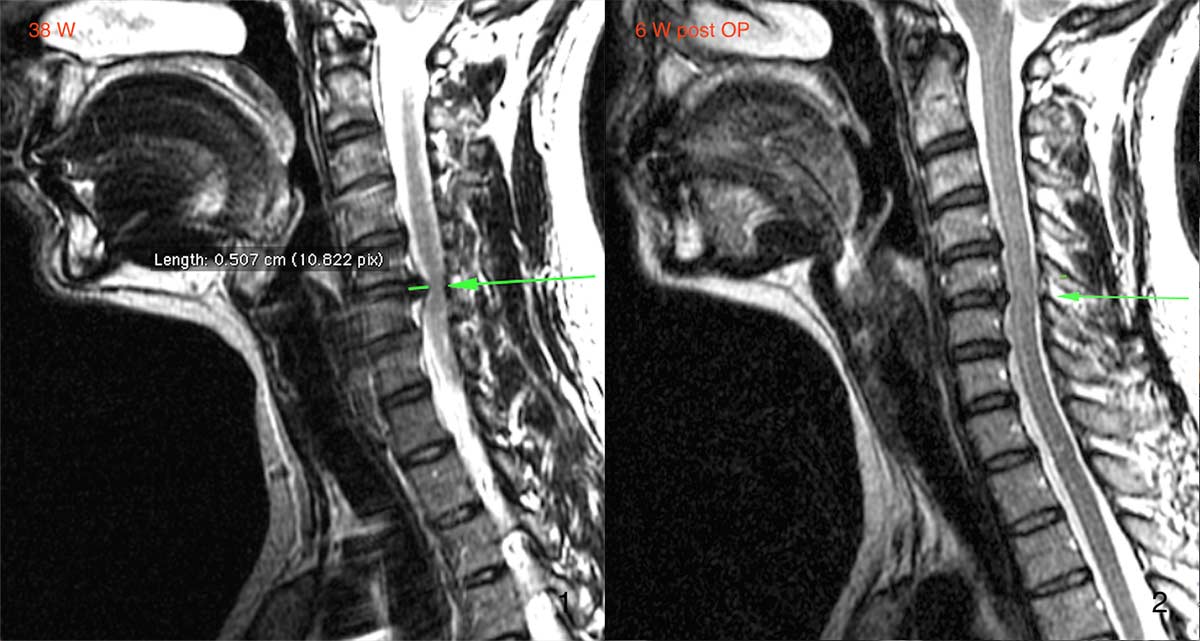
MRI images description: MRI above was done before and four months after the surgery, where the C5/C6 intervertebral hernia is not present. Ossified herniated disc of thoracic spine
Case: 1.A.BSV.6.19.20.25
50 years (male)
Status before the surgery
Pains and Paresthesia in thoracic, lumbar spine, irradiating to the right and left by intercostal spaces and to the lateral and frontal wall of the stomach on the right, on T5-T12 levels. Para paresis of the thorax on the right side, and lateral and frontal stomach wall. Dysfunction of inner organs, especially liver, pancreas and intestine was noted during 8 month. Symptoms were worsening. Pain in Lumbar area, paresthesia of legs and feet. Patient was on very strong painkiller medication.
Diagnosis
Old compression fracture of thoracic spine T8 and T9 with ventrolateral concussion disc extrusion on the right, size of 25mm by 15 mm. Ventral central lateral osteodiscogenic stenosis with spinal cord injury (Dura mater) and commissures in T6/T7. Compression of T7 nerve roots on both sides.
Performed surgery
Flexible epidural catheterization of spine canal ventrally. Mechanical destruction of osseocartilaginous ventral stenosing correlation and following dilatation with CGF.
Surgery result
Surgery was performed in June of 2015. All the symptoms disappeared in a week and currently absent. Patient is not limited in everyday activities or professional and sport live.
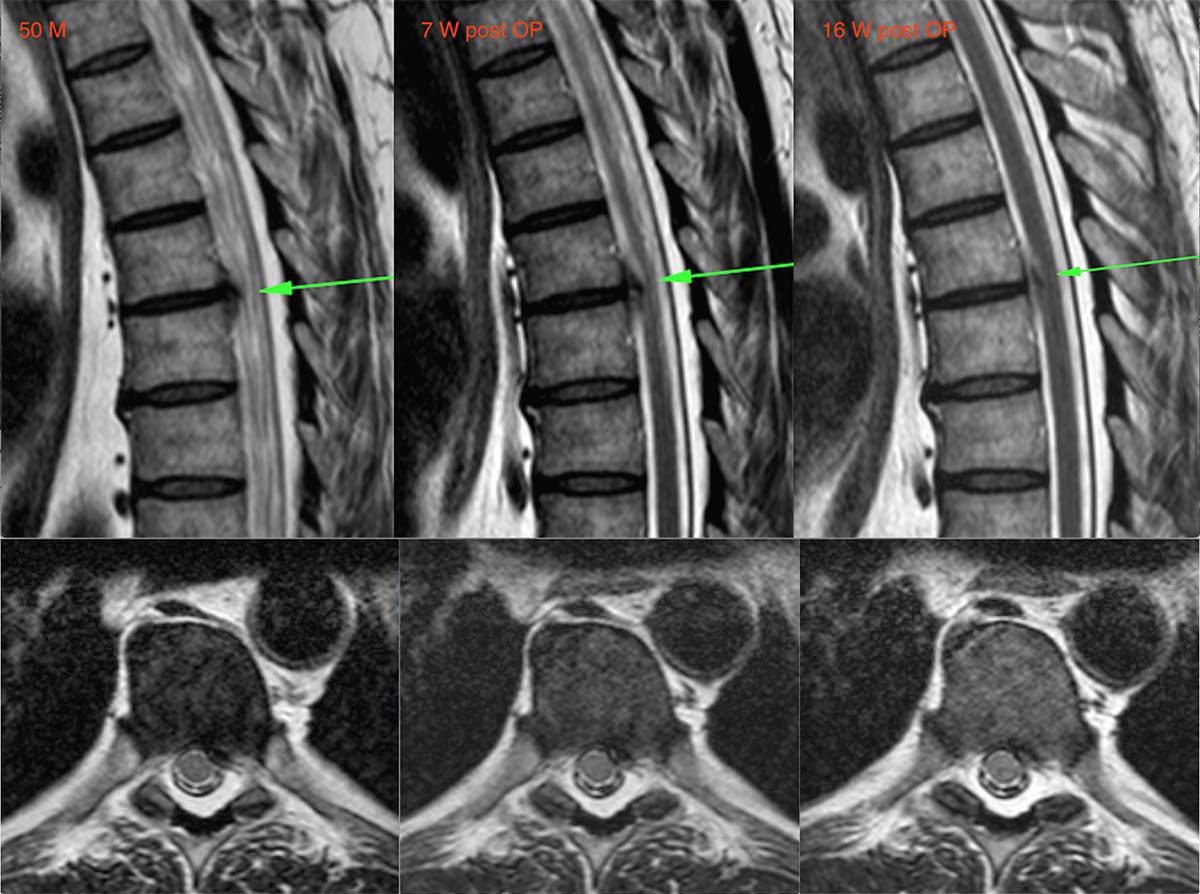
MRI images after 3 month on 21.09.2015. Absolute stenosis of the spinal canal due to a herniated disc in the lumbar spine
Case: 1.A.BSV.7.19.20.25
54 years (female)
Status before surgery
Strong pains in Lumbar area with irradiation to the right leg and foot and left buttock. In standing position, the body leans to the right. Coxalgic pelvis. Autonomous movement or standing position are impossible. Lack of strength and sensitivity in the right leg and foot. Lack of sensitivity on outer thigh of the left leg.
Diagnosis
Right sided scoliosis., ventral spondylolisthesis with vertebral displacement of L4 to L5 for 6mm. Central lateral hernia of intervertebral disc L5/S1 of 14mm. Protrusion of intervertebral disc and stenosis of spinal canal L4/L5 due to spondylolisthesis. Neuroforaminal stenosis from both sides, due to the hernia. Paraparesis of the right leg.
Performed surgery
Hard epidural catheterization of spinal canal. Transforaminal peridural catheterization of spinal canal on L4/L5, L5, S1 levels. Peridural catheterization on L3/L4 levels from both sides. Intra-articular catheterization on L3/L4, L4/L5, L5/S1 levels on both sides. Intervertebral right sided catheterization on L4/L5, L5/S1 levels with CGF. Catheterization of frontal and dorsal longitudinal ligaments L4/L5 levels.
Surgery result
Positive result was immediate after the surgery; patient could move and be in standing position without crutches. All the symptoms disappeared after 2 weeks and after 6 weeks patient could do any physical activity, including sport without limitation. Currently symptoms are not present.
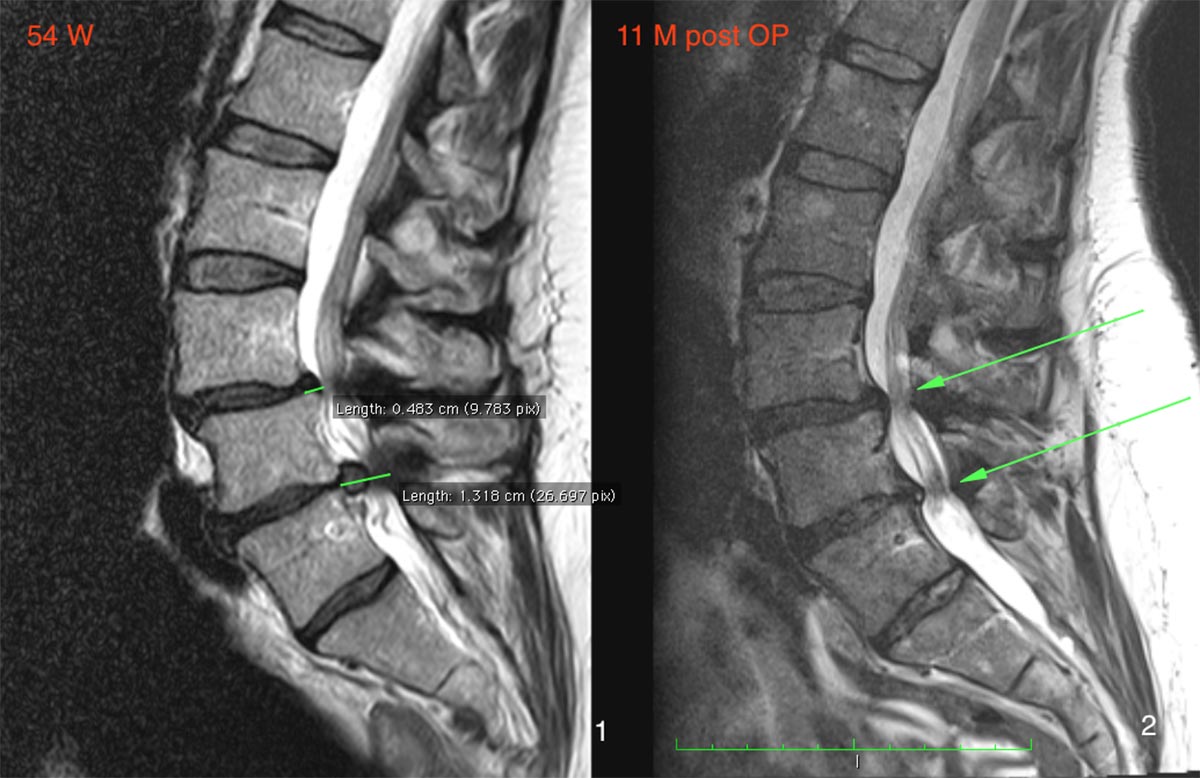
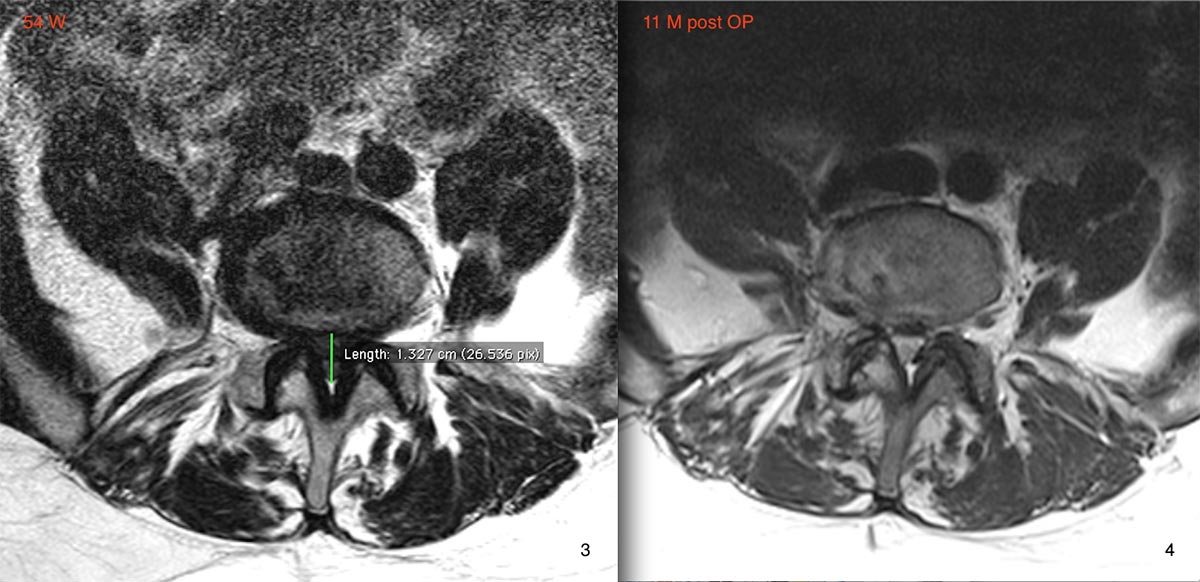
MRI images before surgery on 03.09.2015 and after surgery on 25.08.2016.
Conclusion
For example, if an inevitable, unclear indication of intervertebral disc resection is present or is exhausted in the event of acute neurological deficits and all the usual conservative or minimally invasive pain therapy methods or blockages, then this problem is to be treated effectively by the MIBRAR method and goes even an important step further.
Appendix
Equipment for micro-endoscopy MIBRAR
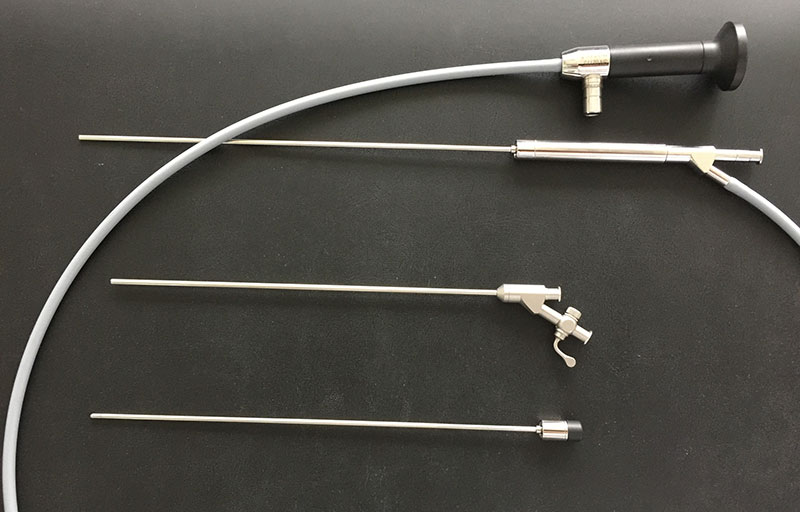
Picture 1. Rigid endoscope with optics outer diameter 2.4mm to 1.7mm oval.
Working length 210mm, working channel 1.1mm.
Trocar with an outer diameter of 2 mm, working length 185 mm.
Obturator blunt (stylet) outer diameter 2.48 mm, working length 213 mm.

Picture 2. Plier’s crocodile outer diameter 1mm

Picture 3. Composed set for endoscopy MIBRAR
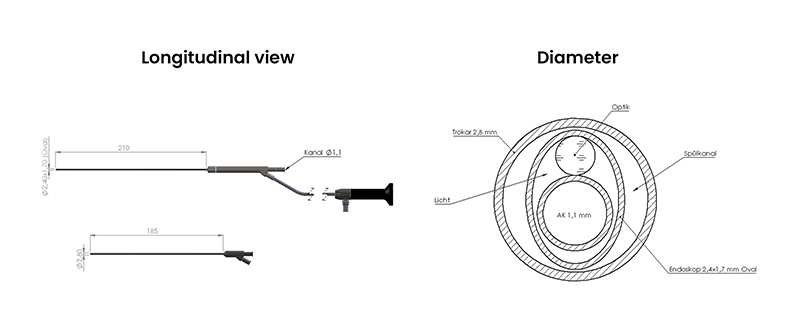
Picture 4. Drawing of the MIBRAR micro-endoscope
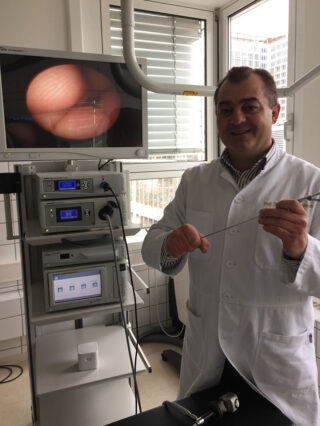
Picture 5. Endoscopic optics with a visibility of 18,000 pixels

